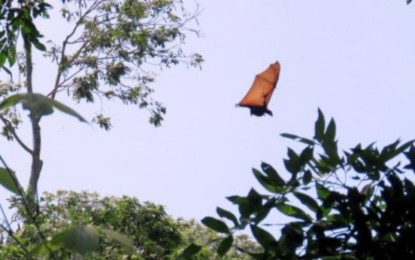
THREATENED. A large flying fox, the largest bat in the world, flies towards its roosting tree in Napol Hills, Barangay Mabuhay, General Santos City. The site is currently the subject of study for declaration as a critical habitat for the said species. (Photo courtesy of DENR-12/PENRO-South Cotabato)
GENERAL SANTOS CITY -- The Department of Environment and Natural Resources (DENR) is pushing for the declaration of a forested hill in an outskirt village here as a "critical habitat" for the threatened large flying fox (Pteropus vampyrus).
Forester Shalimar Disomangcop, the outgoing head of the Provincial Environment and Natural Resources Office (PENRO)-South Cotabato, said the move aims to protect around 7,000 large flying foxes in the city.
Disomangcop said the site covers around 25 hectares in Nopol Hills, Barangay Mabuhay, which is one of the city's tourist attractions.
"We have to ensure that the remaining population of the large flying fox will be protected from hunting, loss of habitat and other threats," he said in a report released over the weekend.
Nopol Hills, which offers a panoramic view of the city, is being promoted by the local government as camping site for adventure seekers.
The area has long been a sanctuary of the large flying fox, which is considered as the largest bat in the world.
Disomangcop said the large flying fox mainly feed on fruits, nectar and flowers, which made them also called as “large fruit bat.”
“They play a biological role in the ecosystem by dispersing seeds and by serving as pollinators of forest trees. Large flying foxes are vital when it comes to pollinating food crops locally, like durian,” he said.
The large flying fox is included in the list of threatened species of the Convention on International Trade on Endangered Species as of 2017 and DENR Administrative Order 2004-15.
Disomangcop said a team from the DENR-PENRO conducted a rapid habitat assessment of the site last week and found thousands of large flying foxes roosting on trees.
The team was assisted by the officials of Barangay Mabuhay and the tenure holder of the Forest Land Grazing Management Agreement 20-2007, which covers Nopol Hills, he said.
The official said the assessment was in line with the provisions of Republic Act 9147 or the Wildlife Conservation and Protection Act of 2001.
Disomangcop said the team found man-made pressures or threats at the site like the cutting of trees and hunting, which might affect the survival of the large flying foxes.
He said they reported these observations to the barangay council of Mabuhay for appropriate action, adding the team will return to the site in the coming days to conduct a perimeter survey and community consultations, he said.
Under DENR Memorandum 2007-02, "critical habitats refer to areas outside protected areas under RA 7586 (National Integrated Protected Areas System Act 1992) that are known habitats of threatened species and designated as such based on scientific data." (PNA)
